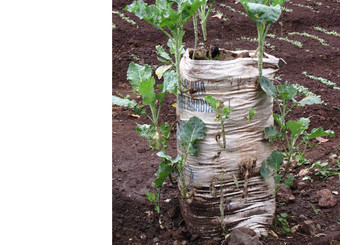Vertical gardening
Vertical gardens, sometimes called sack gardens, were introduced in the CCPM after participants in Chikwawa requested help to grow vegetables despite water shortages.
Vertical gardens consist of sacks filled with soil around a column of stones. The sacks stand upright, and holes are made on the sides of the sack where vegetables are planted. This maximises food production while using limited space, water and labour.

It’s one of a range of innovative agroecology techniques that CCPM farmers were trained in last year, which they have passed on to others in their communities with the support of one of the programme’s implementing partners: the Centre for Integrated Community Development (CICOD).
One farmer who has been using the vertical gardens technique is Norah Saini (above), who said she had lost most of her maize harvest in the March floods.
“This garden gives me security as I lost my other crops. I knew I could depend on this garden. It is developing very nicely. Throughout the year it provides vegetables for us so it solves a lot of problems.”
The amount of water required per day by vegetables in a typical backyard garden will water the same number of vegetables in a vertical sack garden for a week, by reducing the water lost to evaporation. This is critical in Chikwawa district, where temperatures are often high.
Vertical gardens are a great example of innovative solutions tailored specifically to the challenges identified by the CCPM communities themselves.